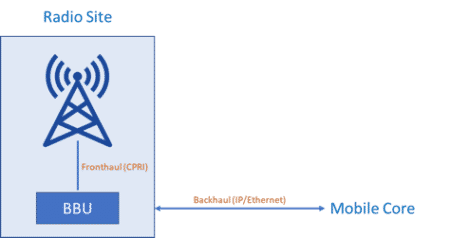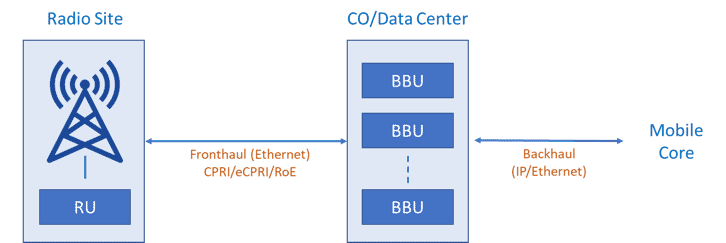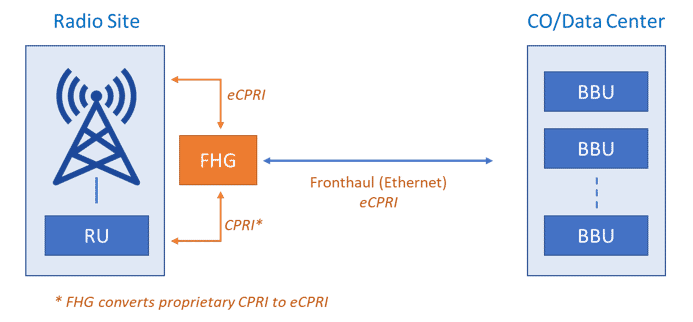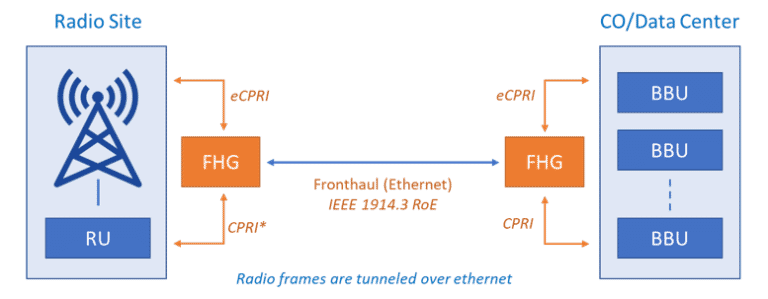As the industry moves from 4G to the more powerful 5G deployments, what worked for 4G doesn’t always work best for 5G. 5G networks allow for a more flexible deployment, especially for Cloud RAN (C-RAN) deployments, and different, more economical option are available for service providers.
First, let us look at the Fronthaul Gateway.
Fronthaul (FH) is a fiber-based transport network between a remote radio head (RRH) and the baseband unit (BBU). A large number of LTE installations followed the Distributed RAN (D-RAN) architecture, hence fronthaul was predominantly a local network at the base station site. The RRH and BBU were separated by TDM based Common Public Radio Interface (CPRI) (Figure 1).

Figure 1 – Fronthaul in 4G RAN
As mentioned, 5G networks will follow a more flexible deployment architecture with a lot of Cloud RAN (C-RAN) deployments (Figure 2). In the C-RAN architecture the BBU is located at a central hub site and there is a transport network between the radio sites and the central hub sites. 5G was envisioned to work with existing LTE networks, when co-deployed (5G and 4G) the C-RAN hub site has the BBU for both LTE and 5G radios.
Common Public Radio Interface (CPRI) requires dedicated fiber, which is very expensive, therefore it is not a feasible option for C-RAN deployments. The use of Ethernet in fronthaul is a more economical option for service providers, hence the CPRI cooperation group has created an enhanced CPRI (eCPRI) protocol that requires fewer transport resources and can be framed within Ethernet to take advantage of Ethernet technologies.

Figure 2 – Fronthaul in C-RAN
Wherever CPRI and eCPRI are deployed together, a FrontHaul Gateway (FHG) can be used to aggregate radio traffic and transport it over Ethernet networks using IEEE 1914.3 RoE (Radio over Ethernet – to encapsulate CPRI onto Ethernet) and eCPRI. The FHG performs encapsulation of CPRI and combines it with eCPRI to maximize the utilization of transport capacity.
Latency requirements in a fronthaul network are in the range of 125 µs RTT (Round Trip Time) including the fiber delay. A 10-km long fiber would approximately incur 50µs of transmission latency per direction. Following are some of the features supported in silicon on the FHG to meet the stringent demands of a FH network:
- IEEE 802.1CM Time Sensitive Networking for Fronthaul
- IEEE 802.1Qbu Frame pre-emption
- IEEE 1914.3 RoE
- CPRI to eCPRI interworking function (proprietary/closed implementations)
- IEEE 1588v2 PTP, Class C timing
- MAC Sec for security
- Support for data rates for LTE and 5G radios (2.4G up to 25G)
Based on the use cases (Figures 3 and 4), the FHG may also be deployed at hub sites to de-tunnel radio frames for processing by the BBU. Since there will be many FHGs in any radio access network, it is desirable to enable remote management of FHGs. The following features are implemented to support remote management in field deployments:
- NETCONF interfaces (SDN control)
- Layer-3/MPLS (provides an option to connect to backhaul)
- Ethernet-OAM

Figure 3 – ORAN Low PHY Split Option

Figure 4 FHG – Radio over Ethernet
One of the leading Ethernet switches for fronthaul networks is Broadcom’s Monterey (BCM 56670 series). The Monterey targets Ethernet-based 5G radios while also supporting existing CPRI-based radios. It supports the IEEE’s new 802.1CM (Time-Sensitive Networking for Fronthaul) standard, which provides an Ethernet synchronization solution, CPRI-to-Ethernet bridging, and nanosecond-scale jitter and delay control.
With our custom software development expertise and deep knowledge of Broadcom chips, IP Infusion Innovations enables its customers to meet the stringent latency and synchronization needs of 5G fronthaul networks.

